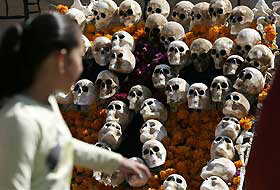 |
 |
 |
 News Around the Republic of Mexico | November 2005 News Around the Republic of Mexico | November 2005  
Mexico Celebrates 'Day of the Dead' with Flower- and Food-Laden Altars to Spirits of the Deceased
 Mark Stevenson - Associated Press Mark Stevenson - Associated Press


| | A student looks at skulls at a floral offering made in honor of Day of the Dead at Mexico National University in Mexico City, Tuesday. Mexicans honor their deceased loved ones on Nov. 1 and 2. |
Mexico City – Mexicans marked the annual Day of the Dead holiday on Tuesday with a towering, 30-foot (10-meter) pile of giant skulls, huge skeletons, vast altars to the dead and large carpets of marigold petals in Mexico City's main square.

Amid the crowd listening to music or waiting for freshly-baked "dead bread" rolls to emerge from huge brick ovens, there were plenty of children dressed up as little witches, skeletons or princesses, illustrating the steady encroachment of U.S.-style Halloween customs.

"That's why we're doing this, to defend our traditions a little," said Fernando Flores, 39, as he walked with his two young sons through the enormous Day of the Dead display, which featured altars erected by unions, political parties and other groups. "I don't have anything against it (Halloween), but it's not our tradition."

Traditionally, the bright orange color of the marigold petals are thought to guide the dead back to their homes – where they "spiritually" nourish themselves from the foods they liked in life.

Home altars include the deceased person's favorite food and drink, along with candles, incense, photos of the dead and other decorations.

The skulls – the giant versions in the display were built by an arts group – represent the small candy skulls traditionally given as gifts, and also the Aztec practice of exhibiting the skulls of conquered enemies. Candy skulls are often engraved with the names of the living, or accompanied by short, ironic poems mourning the "death" of a living friend.

Asked which he preferred – this rich panoply of Mexican tradition, or Halloween – Flores' son, Juan Manuel, 8, quickly piped up, "Halloween ... because of the 'calaverita'," as trick-or-treating here is known.

Mexican children often go about asking for money for their 'calaverita' – a small plastic pumpkin – rather than candy.

Like the Flores, the Callejas family tries to do both: set out traditional altars to deceased grandparents, while also allowing their children to join in Halloween-style festivities.

Francisco Javier Callejas, 7, visited the Day of the Dead exhibit dressed up in a Halloween costume as a soldier – his younger brother wore a skeleton costume – and said he liked both festivities.

His mother, Irma Callejas, 35, said she made a constant effort to keep Mexican traditions alive. "We want them to know that there are other customs, but they are from other countries, not ours," said Callejas.

It's just the first round in the holiday battle: Christmas decorations are already going up in stores – Santa Clauses and reindeer, in addition to more traditional nativity scenes – and Callejas she will have to keep her kids from expecting gifts on Christmas day, rather than the traditional Jan. 6 Three Kings Day.

Some took a philosophical attitude toward the battle between Halloween and Day of the Dead, itself a mix of pre-Hispanic and Catholic customs.

"It's all the same thing," said Luis Aquino Gallegos, 7 as his mother bought him a plastic scythe, and his sister a small broomstick, as they left the more traditional festival.

Traditional celebrations last through Nov. 2, when families honor deceased children. Many families will make nighttime visits to graveyards, to commune with dead relatives.

A caravan of two dozen Indian women from the southern state of Chiapas arrived Monday in the northern border city of Ciudad Juarez to honor the hundreds of women who have been slain there in the past decade.

The women lit candles, blew conch shells, beat drums and burned incense in what they described as a ceremony of respect for the dead and solidarity for the victims' surviving relatives. The caravan was dubbed "the Wind of 1,000 Voices." | 
 | |
 |



